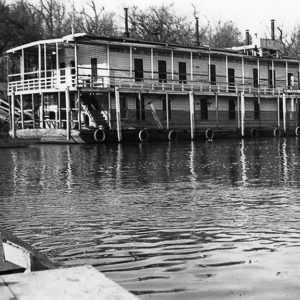calsfoundation@cals.org
Floating CCC Camp at Jacks Bay
The Civilian Conservation Corps (CCC) side camp BF-2 at Jacks Bay in Arkansas County was distinct from most other CCC camps in Arkansas in two ways: the enrollees were African American rather than white, and they were housed in floating government quarterboats rather than in barracks or tent camps. The side camp at Jacks Bay was occupied from January 1936 until May 1938, when it was abandoned, the boats removed, and the personnel integrated into another camp.
The Jacks Bay side camp had its origins in President Franklin D. Roosevelt’s Executive Order 7173, issued on September 5, 1935, that authorized the Bureau of Biological Survey to acquire 110,000 acres on the Lower White River for protection and conservation of migratory birds and other wildlife. Three main CCC camps were assigned to this refuge: Company 1741 at St. Charles (Arkansas County), Company 3791, and Company 3776 at Camp Lagrue, which is now known as the Dale Bumpers White River National Wildlife Refuge (NWR).
Company 3776 (BF-2) established the side camp at Jacks Bay, ten miles south of the main camp, to facilitate work projects in the remote southern portion of the refuge and reduce travel time. As was typical of CCC camps, in addition to the project job and safety training at Camp BF-2, there were various educational, welfare, and religious programs, as well as dances and a camp newspaper: The Lagrue Legend.
The first quarterboats for housing the men at the floating side camp were the Blue Peter (MW-118) and the Marionette (MW-117), which were obtained from the U.S. Army Corps of Engineers in November 1935; later the Green Heron (MW-158) was also moored at Jacks Bay. The two-story quarterboats served as the men’s homes and contained kitchens, mess halls, plumbing, and electrical systems. The floating camp was segregated, with the Black CCC enrollees being housed in different quarterboats from the white supervisors, foremen, and machine operators.
The enrollees at Company 3776 (BF-2) can be credited with developing the early infrastructure in the southern portion of the White River NWR. Their monthly narrative reports are illustrated with black-and-white photographs, categorizing labor and offering project descriptions. In terms of man-days expended, the most significant BF-2 job was the construction of truck trails (13,994 man-days, or 44 percent of the total labor). The construction of fences ranked second in expended labor (4,349 man-days), and this required the cutting of wood for posts and then creosoting those posts. Construction of fire breaks ranked third, followed by the building of earthen dams. A wide variety of other tasks consumed the remaining labor, including the construction of metal observation towers.
The Flood of 1937 took place during the occupation of the BF-2 side camp at Jacks Bay. The high waters necessitated moving the quarterboats at least three times. The CCC camps supported relief efforts, and in January 1937 the floating side camp at Jacks Bay supplied seventeen trucks and forty enrollees to help move refugees from danger at Humphrey (Arkansas and Jefferson counties) and Clarendon (Monroe County) to refugee camps at Brinkley (Monroe County) and Forrest City (St. Francis County).
For additional information:
Albertson, Eric, and C. Andrew Buchner. “Phase I/II Archaeological Investigations and Evaluation FW-WHRI 13(1)-Resurfacing of Jacks Bay Landing Road and Drainage Improvements, Arkansas County, Arkansas.” Panamerican Consultants, Inc. Report No. 37098. Submitted to the Federal Highway Administration and the U.S. Fish and Wildlife Service, Southeast Region, 2018. On file at the Arkansas Archeological Survey, Fayetteville, Arkansas.
Civilian Conservation Corps. “Official Annual 1937: Civilian Conservation Corps Arkansas District Seventh Corps Area.” Copy on file at the U.S. Fish and Wildlife Service, Hardeeville, South Carolina.
C. Andrew Buchner
Panamerican Consultants, Inc.
 Early Twentieth Century, 1901 through 1940
Early Twentieth Century, 1901 through 1940 Environment
Environment Politics and Government
Politics and Government CCC Enrollees
CCC Enrollees  Quarterboat
Quarterboat 




Comments
No comments on this entry yet.